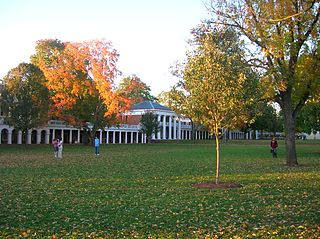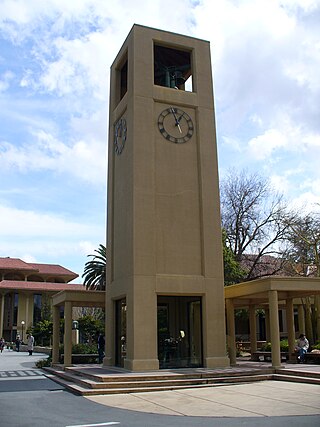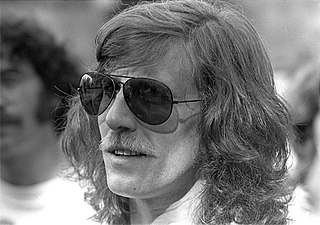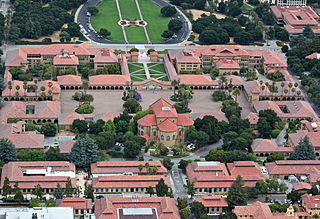
The Oval is an oval-shaped sunken lawn on the Stanford University campus in Stanford, California, United States. [1]
The lawn once had a statue called Faith. The Olmsted Brothers recommend removing the statue in 1914. [2]

The Oval is an oval-shaped sunken lawn on the Stanford University campus in Stanford, California, United States. [1]
The lawn once had a statue called Faith. The Olmsted Brothers recommend removing the statue in 1914. [2]
Knowledge Systems Laboratory (KSL) was an artificial intelligence research laboratory within the Department of Computer Science at Stanford University until 2007, located in the Gates Computer Science Building, Stanford. Work focused on knowledge representation for shareable engineering knowledge bases and systems, computational environments for modelling physical devices, architectures for adaptive intelligent systems, and expert systems for science and engineering. KSL had projects with Stanford Medical Informatics (SMI), the Stanford Artificial Intelligence Lab (SAIL), the Stanford Formal Reasoning Group (SFRG), the Stanford Logic Group, and the Stanford Center for Design Research (CDR).

The Cecil H. Green Library is the main library on the Stanford University campus and is part of the SUL system. It is named for Cecil H. Green.

The Rotunda is a building located on The Lawn on the original grounds of the University of Virginia. Thomas Jefferson designed it to represent the "authority of nature and power of reason" and modeled it after the Pantheon in Rome. Construction began in 1822 and was completed shortly after Jefferson's death in 1826. The campus of the new university was unique in that its buildings surrounded a library rather than a church, as was common at other universities in the English-speaking world. To many, the Rotunda symbolizes Jefferson's belief in the separation of church and education, and represents his lifelong dedication to education and architecture. The Rotunda was designated a National Historic Landmark in 1966, and is part of the University of Virginia Historic District, designated in 1971.

The Doe Memorial Library is the main library of the University of California, Berkeley Library System. The library is named after its benefactor, Charles Franklin Doe, who in 1904 bequeathed funds for its construction. It is located near the center of the Berkeley campus, facing Memorial Glade, and is adjacent to and physically connected with the Bancroft Library. In 1900, Émile Bénard won an architectural competition for the design of the library, and the Neoclassical-style building was completed in 1911. The Doe Library building is the gateway to the underground Gardner (Main) Stacks, named in honor of David P. Gardner, the 15th President of the University of California.

The Lawn, a part of Thomas Jefferson's Academical Village, is a large, terraced grassy court at the historic center of Jefferson's academic community at the University of Virginia. The Lawn and its surrounding buildings, designed by Jefferson, demonstrate Jefferson's mastery of Palladian and Neoclassical architecture, and the site has been recognized as an architectural masterpiece in itself. The Lawn has been designated a U.S. National Historic Landmark District, and is part of a UNESCO World Heritage Site along with the original buildings of the University of Virginia and Monticello, Jefferson's nearby residence; this designation is due to the site's architectural and cultural significance.
The Center for Advanced Study in the Behavioral Sciences (CASBS) is an interdisciplinary research lab at Stanford University that offers a residential postdoctoral fellowship program for scientists and scholars studying "the five core social and behavioral disciplines of anthropology, economics, political science, psychology, and sociology".

The Stanford Clock Tower with its attached, colonnaded pergola is located at the so-called “Circle of Death” at the corner of Escondido and Lasuen Malls on the campus of Stanford University. It was built in 1983 by a donation from trustee William Kimball.

The Gates Computer Science Building, or Gates building for short, is an L-shaped building that houses the Computer Science Department as well as the Computer Systems Laboratory at 353 Jane Stanford Way, Stanford University, California. Construction on the building began in 1994 and was completed in 1996 at a cost of $36 million. It was named after Microsoft founder Bill Gates, who donated $6 million for the building's construction.

Dedicated on October 21, 1993, the Cecil H. and Ida M. Green Earth Sciences Research Building at Stanford University houses classrooms, offices, and laboratories for research in the field of earth sciences. The building's extended basement contains the sunken Kresge Plaza, in which rock sculptures are designed to look like a miniature version of local geologic faults. It is named for Cecil Green, who co-founded Texas Instruments in 1951 with Erik Jonsson and Eugene McDermott.

Braun Music Center, known colloquially as Braun, is a music education building at Stanford University in California. Opening its doors in 1984, Braun serves as both the epicenter for music at Stanford, as well as a link between Stanford's main residential and activities centers. As the main building for the Department of Music, Braun is the venue for the department's concerts and recitals and offers rehearsal studios and practice facilities as well as classrooms and offices.

Memorial Hall, was built in 1937 to commemorate those students and faculty from Stanford University who died in World War I. Designed by Arthur Brown, Jr. in conjunction with Bakewell and Weihe, construction of the building was funded primarily through student contributions.

The Fire Truck House, built by Charles Hodges in 1904, served as Stanford University's firehouse until the early 1970s, when the current firehouse was built on Serra Street. It was staffed by a mix of students and professional firefighters. The students received room, board, and a stipend. A few later made firefighting a career, including William R. Bamattre, Chief of the Los Angeles City Fire Department from 1996 to 2007, and Nick Marinaro, Chief of Palo Alto Fire Department from 2004 to 2010.

Abraham Lincoln: The Man is a larger-than-life size 12-foot (3.7 m) bronze statue of Abraham Lincoln, the 16th president of the United States. The original statue is in Lincoln Park in Chicago, and later re-castings of the statue have been given as diplomatic gifts from the United States to the United Kingdom, and to Mexico.

The Lone Sailor, a 1987 bronze sculpture, is a tribute to all the personnel of the sea services. The sculpture was created by Stanley Bleifeld, for the United States Navy Memorial in Washington, D.C.

The Laurence Frost Amphitheater, commonly known as Frost Amphitheater, is a prominent amphitheater at Stanford University. It first opened in 1937 and was the site of commencement ceremonies for the university from 1938 until 1984. It can hold about 8,000 people.

Lane Medical Library is the library of the Stanford University School of Medicine at Stanford University, near Palo Alto, California. Its mission is to "accelerate scientific discovery, clinical care, medical education and humanities through teaching, collaboration, and delivery of biomedical and historical resources". It is located on campus adjacent to Stanford Hospital and Clinics. In addition to books, journals and documents for medical research and the teaching and practice of medicine, Lane Library houses a significant collection of material relating to the history of medicine. The library also provides specialized search capabilities, classes and tutorials, writing and grant support, and group and individual study spaces.

The Keystone, also known as Keystone Berkeley, was a small music club at 2119 University Avenue in Berkeley, California, which operated in the 1970s and 1980s. Numerous nationally known groups performed there, including Tom Petty and the Heartbreakers, Ray Charles, Talking Heads, The Ramones, Metallica and B.B King, Blondie, and Greg Kihn among many others and the club was a regular venue for the Jerry Garcia Band. Keystone Berkeley, run by Freddie Herrera and Bobby Corona, was linked to The Stone and Keystone Palo Alto.

The Main Quadrangle, or more commonly Main Quad or simply Quad, is the heart and oldest part of Stanford University in California. The collection of connected buildings was started in 1887 and completed in 1906. The Quad was damaged in the 1906 earthquake, repaired, less severely damaged in an 1989 earthquake, and repaired again. The exteriors have remained almost the same since the beginning, though the interiors of most of the buildings have changed radically. The Main Quad is still used for its original purposes of teaching, research, and administration.

The Catacombs was a gay and lesbian S/M leather fisting club in the South of Market area of San Francisco, which operated from 1975 to 1981, and reopened at another location from 1982 to 1984. It was the most famous fisting club in the world. The founder and owner was Steve McEachern. The location was semi-secret and admission was by referral only. It was originally a gay men's club, but Cynthia Slater persuaded the management to open up to lesbians. Among the patrons was Patrick Califia, known then as Pat Califia. The Catacombs has been exhaustively described by sexual anthropologist Gayle Rubin, who calls it "exemplary" in its attempts to deal with the AIDS crisis which would eventually lead to its closure. Patrick Moore devotes a chapter to it in his Beyond Shame: Reclaiming the Abandoned History of Radical Gay Sexuality. Sex educator Carol Queen called it "the place to be seen and to play at during the 1980s."

Tanner Fountain is a fountain on the Stanford University campus in Stanford, California, United States. Located between Hoover Tower and Memorial Auditorium, the fountain was installed in 1977, having been donated by Obert Tanner and his wife to commemorate their son. The couple had been planning to fund the project since 1972, and installation and landscaping cost less than $250,000.
37°25′47″N122°10′10″W / 37.42986°N 122.16948°W